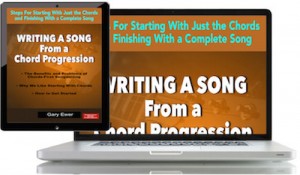Whether you come up with the chords and then create a melody, or have a melody that you want to add chords to, you need to be sure that the chords are properly supporting the melody.
When chords and melody work well together, you have the happy circumstance that they both sound better than they might sound on their own. But the opposite is true as well: when there are problems with chords not properly fitting with the melody, they can both sound worse.
 “The Essential Secrets of Songwriting 10-eBook Bundle” comes with an excellent Study Guide that’s meant to get your songwriting moving in the right direction. Also comes with a FREE eBook, “Use Your Words! Developing a Lyrics-First Songwriting Process.”
“The Essential Secrets of Songwriting 10-eBook Bundle” comes with an excellent Study Guide that’s meant to get your songwriting moving in the right direction. Also comes with a FREE eBook, “Use Your Words! Developing a Lyrics-First Songwriting Process.”
It shouldn’t surprise you that so much of this aspect of songwriting is guided by your instincts. But you can help your instincts by considering these five important tips:
1. Change chords mainly on strong beats.
The strong beats are the ones that begin each bar of music, so in that case we’re talking about changing chords every four beats. If you want to change chords more often, change every two beats. (Changing every three beats works for songs in 3/4 time.)
In a song like Lennon & McCartney’s “Let It Be”, the chords change every two beats. The verse of Michael Jackson’s “Thriller” holds each chord for eight beats (two full bars) before changing. So as you can tell, there’s no rule here, but consistency is important.
In any song, you can make changes as you go — sometimes changing every four beats, then every two, then back to four. But one of those choices should be the main occurrence for that particular song.
2. At the point of a chord change, the melody note should belong to the chord.
The melody note always needs to feel supported by the chord that’s underneath. So if the melody note is C, you’ll have choices: mainly, whichever chord has a C as one of its notes.
3. Let the mood of the song control how often the chords change.
In general, quickly changing chords tends to increase the musical energy of a song. So you can use the frequency of chord changes as a way of boosting the power of a song. In “Let It Be”, the fact that the chords change every two beats gives the song a more relaxed feel, and suits the melody (and lyric) well.
But don’t misunderstand: you can still have intense musical energy with chords that don’t change at all, if you’ve got power in your instrumentation and playing style (as in The Guess Who’s “American Woman”). But if you’re looking to add a bit of intensity, think about ways to increase the speed of your chord changes.
4. Melody notes between chord changes don’t need to belong to the chord of the moment.
While it’s true that the melody note that happens right at the moment of a chord change should belong to that chord, the melody notes in between chord changes can include lots of non-chord notes.
“Groovy Kind of Love” uses lots of scalewise passages in the melody, changing chords mainly every four beats. That means that most of the notes between chord changes don’t actually belong to the chords that are happening. But they sound great, because the melody note at the point of a chord change always fits the chord.
5. When arranging your song, consider using implied chords.
This is more a production issue than a songwriting one, but it’s important: just because you’re playing, let’s say, a C chord shouldn’t necessarily mean that you’ve got to have all the notes of that C chord present.
A good demonstration of this is Billy Joel’s “It’s Still Rock and Roll to Me.” The opening chord progression is C-Em-Bb-F, but the only instruments playing are the bass and guitar playing the roots of those chords. Billy gives one extra note for each chord with his vocal line.
When you’ve got an incomplete chord like this, it’s called an implied chord — our musical brain fills in the notes that are missing.
What good are implied chords? They work well in verses, where you might want the instrumentation to be thinner — a bit more transparent. It allows for a more effective build to a fuller chorus.
 Written by Gary Ewer. Follow Gary on Twitter.
Written by Gary Ewer. Follow Gary on Twitter.
 To discover the most important secrets of the chords-first songwriting process, read “Writing a Song From a Chord Progression.” It’s part of “The Essential Secrets of Songwriting 10-eBook Bundle.”
To discover the most important secrets of the chords-first songwriting process, read “Writing a Song From a Chord Progression.” It’s part of “The Essential Secrets of Songwriting 10-eBook Bundle.”










